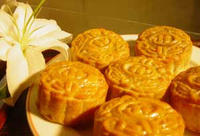
VietNamNet –
Mid Autumn Festival is coming and moon cake shops are bustling.
An indispensable present
Although Mid-Autumn, which falls on September 18 this year, has not yet come, moon cakes are already selling like proverbial hotcakes.
Confectionary shops are so busy, with customer demand for the cakes high. Parents buy the cakes for their children, friends offer them to each other, and employees present them to their bosses.
The custom of eating moon cake can be dated back thousand of years. Moon cakes symbolise the reunion of families and couples. The exchanging of gifts during the mid autumn festival is an hospitable custom and lovers give moon cakes to show their passion.
A number of poets and intellectuals have taken inspiration from the festival, and traditional moon cakes, in the creation of classic poems and stories. However, these days many people eat moon cake with little knowledge of tradition.
Nguyen Thi Yen, 59, mother of two, grandmother of one, said she buys moon cakes for her children every Mid-Autumn festival, copying her mother’s habit, without asking why.
“I hate eating confectionary, but I have never quit eating moon cake. I can not exactly explain why, I just think I must keep up the habit for my ancestors, and for my children”, the 59 year old woman said.
Ms Yen believes that nobody knows exactly when the custom of eating moon cakes or the celebration of the Moon Festival began, but that most people think the habit comes from China.
Indeed, at the time moon cakes came into being, China was in revolt against the Mongols, and a general and his senior deputy discussed battle plans involving a secret cake strategy to take a certain walled city held by the Mongol enemy.
The senior dressed up as a priest and entered the besieged city bearing the secret cakes. He distributed them to the city's Chinese residents, and when Mid-Autumn festival arrived, people opened their cakes and found hidden messages inside, advising them to coordinate their uprising with troops outside.
Thus, the general ingeniously took the city and his throne. Since then the cake has been known as moon cake, and is eaten at Mid-Autumn festival.
During Mid-Autumn festival, moon cake, including banh deo (sticky rice cake) and banh nuong (baked cake), are served along with fruit to the ancestors. They are later eaten during “Pha Co”, the most anticipated step of the festival.
Art in the kitchen
Moon Cake is a ubiquitous dish of Mid-Autumn festival, not only because of the legend which surrounds it, but also for its cultural and artistic connotations. The cakes with their various flavors and delicate packaging have actually become a kind of artwork. People can experience aesthetic pleasure while enjoying the food.
Moon cakes are round pastries about an inch in height. Inside, they are filled with lotus seeds, red bean paste, orange peel, melon seeds, ham, dried flower petals, and salted duck egg yolks.
The surface is often patterned with clouds, the moon, rabbits, or its maker’s own images. Generally leading up to the festival, confectionary companies advertise the uniqueness of their product to consumers, while keeping their precise methods secret.
Invited Chinese chefs, Zhong Jinbo and Liao Jianqing, have brought their talent for the sweet cakes to the Hilton Hanoi Opera Hotel each Autumn over recent years. According to the chefs, Quang Zhou Province, where they are from, is famous for its food. “I have loved moon cakes since I was very young, and spent hours in the kitchen learning how to make them,” said Liao at a Hanoi press conference.
“I started when I was 14 and it took me two or three years to learn how to make them,” Zhong said. “For a long time I just whipped the eggs, then I learned how to make the crust and how to stuff them, before I actually began baking my own moon cakes.”
According to the Quang Zhou chefs, Chinese people value the cakes’ quality depending on the pastry: the thinner, the better. Zhong explained that the stuffing is the most expensive and delicious part of the moon cake, thus deciding its quality.
He has learnt this over the past ten years making the cakes, and as a prestigious chef, Zhong intends to make as many cakes with as many different stuffings as possible. Zhong also claims the key to success is flexible working times, careful preparation and willingness to shoulder responsibility for the final product.
This year Zhong Jinbo and Liao Jianqing bring Vietnam their new creations: moon cakes with stuffings such as coconut and fresh tea leafs. Of course, the cooks did not reveal how they make the cakes, but said that it is very special and different from other bakers.
Busy business
Beginning early in the eighth lunar month, moon cakes are sold on virtually all streets.
Kinh Do, one of the country largest confectionary makers, announced that they will produce more than 1,500 tonnes of various moon cakes this festival, following is Bibica with 240 tons and Vinabico with 200 tons. Hotels and restaurants have also made moon cakes for the festival, offering the treat as an opportunity to build their brand names via various moon cake products and promotions.
This year a special ‘diet cake’ is also on sale. Many companies offer the product, at the demand of their customers. The cost is VND25,000 to 40,000 per cake or VND200,000 – 400,000 per 6-cake box. Special cakes with abalone or shark-fin stuffing sell for VND300,000 – 400,000 per box, or even up to VND1mil per box for specialty products.
引用:http://english.vietnamnet.vn/vndiaries/2005/09/485824/